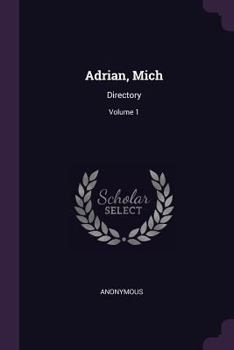Adrian, Mich: Directory; Volume 1
Select Format
Select Condition 
Book Overview
Customer Reviews
Rated 5 starsCompact And Clear MYSQL Reference
'MySQL in a Nutshell' is another solid release in the family of 'Nutshell' books by O'Reilly. As with all other Nutshell books, this isn't a learning book, moreso a shorter reference manual for experienced developers who know what they are using and need a guide to help them out through the process. With MySQL In A Nutshell you are getting exactly that. Spread over nearly 550 pages and 19 Chapters, here's an overview of...
0Report
Rated 4 starsIt does not cover MySQL 5 or later.
It's a great reference but dated. If I had known that it only covers through version 4, I would not have purchased it.
0Report
Rated 5 starsMySQL and how to use it effectively!
The book is "A Desktop Quick Reference" just as billed on the cover. It is explicitly MySQL-centric and doesn't stray from that core message. It is extremely up-to-date considering the rapidity of movement in MySQL development progress. I feel that its author, Russell Dyer is the kind of person who is easy to talk to and immediately be comfortable with based on his style and presentation in this book. The content of this...
0Report
Rated 4 starsAnother Solid Nutshell Book
Ah, "Nutshell" books - you gotta love `em. Or maybe you don't. I won't get into the pros and cons of online documentation versus books because this subject has been rehashed ad infinitum. Truth is, there are pros and cons for both, and we each have our own reasons for our own preferences. That being said, if you like book documentation - and "Nutshell" books in particular - then you will like this book. I happen to think it...
0Report
Rated 4 starsyou need a background in SQL
Well the book certainly seems to cover MySQL's features quite comprehensively. But, as it is a reference manual, it does not attempt to teach you MySQL or the theory of relational databases. For a given MySQL command, the book's explanation is succinct and useful. Provided you already have a background in the area. Much of the book's discussion is probably already available in equivalent form in the online help. But hardcopy...
0Report





















